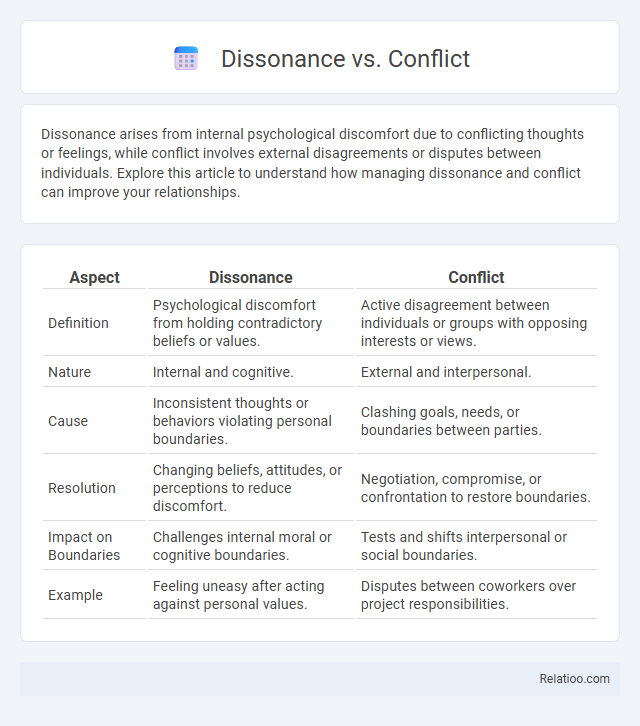Dissonance arises from internal psychological discomfort due to conflicting thoughts or feelings, while conflict involves external disagreements or disputes between individuals. Explore this article to understand how managing dissonance and conflict can improve your relationships.
Table of Comparison
| Aspect | Dissonance | Conflict |
|---|---|---|
| Definition | Psychological discomfort from holding contradictory beliefs or values. | Active disagreement between individuals or groups with opposing interests or views. |
| Nature | Internal and cognitive. | External and interpersonal. |
| Cause | Inconsistent thoughts or behaviors violating personal boundaries. | Clashing goals, needs, or boundaries between parties. |
| Resolution | Changing beliefs, attitudes, or perceptions to reduce discomfort. | Negotiation, compromise, or confrontation to restore boundaries. |
| Impact on Boundaries | Challenges internal moral or cognitive boundaries. | Tests and shifts interpersonal or social boundaries. |
| Example | Feeling uneasy after acting against personal values. | Disputes between coworkers over project responsibilities. |
Understanding Dissonance and Conflict
Dissonance refers to the psychological discomfort experienced when holding two or more conflicting cognitions, often leading to an internal drive for resolution. Conflict involves an external struggle between opposing forces or parties, manifesting socially or interpersonally rather than within an individual's mind. Understanding dissonance emphasizes cognitive inconsistency and motivation for change, while conflict centers on interactions and opposing interests in social contexts.
Defining Dissonance in Everyday Life
Dissonance in everyday life refers to the psychological discomfort experienced when holding two or more contradictory beliefs, values, or attitudes simultaneously. Unlike conflict, which typically involves external disagreements between individuals or groups, dissonance occurs internally and motivates individuals to reduce the inconsistency through cognitive adjustments. Understanding how dissonance influences decision-making and behavior is key to recognizing its role in personal growth and social interactions.
What is Conflict? Key Characteristics
Conflict is a dynamic process where opposing viewpoints, interests, or values create tension between individuals or groups, often leading to disagreements or clashes. Key characteristics include perceived incompatibility, interdependence of parties, and interaction where parties are aware of the conflict. Understanding these elements can help you manage disputes effectively and foster resolution.
Psychological Roots: Dissonance vs Conflict
Psychological roots of dissonance lie in cognitive imbalance, where Your mind experiences tension from holding contradictory beliefs or values simultaneously, driving a need for mental resolution. Conflict, however, originates from perceived opposition between individuals or groups, fueled by incompatible goals or interests that trigger emotional and behavioral responses. Understanding these distinctions helps in effectively addressing internal discomfort versus interpersonal disputes in psychological contexts.
Types of Dissonance in Human Behavior
Types of dissonance in human behavior include cognitive dissonance, emotional dissonance, and social dissonance, each reflecting different internal and interpersonal tensions. Cognitive dissonance arises when individuals hold contradictory beliefs or attitudes, creating mental discomfort that motivates attitude or behavior change. Emotional dissonance occurs when there is a mismatch between experienced emotions and those expressed outwardly, often seen in workplace settings where individuals must display emotions contrary to their true feelings.
Common Forms of Conflict in Society
Common forms of conflict in society include interpersonal conflicts, group conflicts, and systemic conflicts, each arising from different sources such as resource scarcity, cultural differences, and power imbalances. Dissonance, often related to cognitive dissonance, occurs when individuals experience mental discomfort due to contradictory beliefs or values, influencing social tensions. Understanding these dynamics helps to address societal disputes by recognizing the interplay between psychological dissonance and overt conflict manifestations.
How Dissonance Leads to Inner Tension
Dissonance generates inner tension by creating a clash between your beliefs, values, or behaviors and external information or experiences that contradict them. This psychological discomfort motivates you to resolve the inconsistency through adjustment of attitudes, seeking new information, or changing behavior to restore cognitive harmony. Understanding this process is crucial for managing personal growth and decision-making under conflicting internal and external influences.
External vs Internal: Conflict and Dissonance
Conflict involves external struggles between opposing forces or individuals, impacting Your environment and relationships, while dissonance refers to internal psychological tension caused by incompatible beliefs or values. External conflicts often manifest as disagreements or confrontations, whereas internal dissonance drives self-reflection and emotional discomfort. Understanding how conflict influences Your social context and how dissonance affects internal harmony is crucial for effective resolution strategies.
Managing Dissonance and Resolving Conflict
Managing dissonance involves recognizing and addressing internal psychological discomfort caused by conflicting beliefs or behaviors, which can improve decision-making and emotional well-being. Resolving conflict requires effective communication, empathy, and negotiation skills to address interpersonal or organizational disagreements, fostering collaboration and mutual understanding. By understanding your triggers for dissonance and actively engaging in conflict resolution strategies, you enhance interpersonal relationships and promote a healthier work or personal environment.
Impacts on Relationships: Dissonance vs Conflict
Dissonance in relationships often causes internal tension and discomfort due to conflicting beliefs or values, leading to misunderstandings and emotional distance. Conflict typically manifests as overt disagreements or disputes that can escalate but also provide opportunities for resolution and growth if managed effectively. While dissonance undermines trust subtly and persistently, conflict highlights specific issues more directly, impacting communication patterns and long-term relationship stability.

Infographic: Dissonance vs Conflict
 relatioo.com
relatioo.com